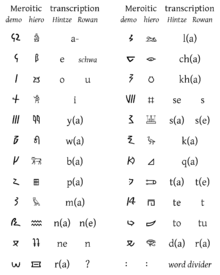Meroitic

This book is a short guide on the Meroitic language intended for those who would like to translate from that language.
Meroitic is a dead language once spoken in the land of Kush in what is today southern Egypt and northern Sudan. It was used in writing from the 3rd century BCE to the 4th century CE. It is presumed to have gone extinct sometime after its last attestation in the late 4th century. The language was displaced in that region by Coptic and Old Nubian.
Meroitic is known from several hundred texts, the overwhelming majority being funerary tablets. The remainder consists of royal stelae, captions to works of art, ostraca, graffiti and temple inscriptions. Three substantive texts of historiographical interest exist: the "Kharamadoye inscription" from Kalabsha, the "Great Stele of Akinadd" from Hamadab and the "Taneyidamani inscription" from Jebel Barkal.
This guide will follow the outline of the language set in Francis Llewellyn Griffith's "Karanog IV: The Meroitic Inscriptions of Karanog and Shablul", published in 1911, and now in the public domain. That book serves as a an adequate introduction to the language and gives treatment to Meroitic funerary stele and ostraca from Karanog, Shablul, cataloged as REMs 201> <400. The book repeatedly makes references to Griffith's earlier treatment of Meroitic from Arika.
This guide will apply the Saharan theory but it will also prove useful to those translating according to Northern Eastern Sudanic and Afro-Asiatic grammarticalisations of the language. The first few lessons are universal as they deal with the language's inherent features.
Before beginning
[edit | edit source]
To view characters encoded in Meroitic cursive and hieroglyphic as well as other missing Unicode characters you will need to install a font such as Unifont.
Lessons
[edit | edit source]- Lesson 1: Phonology and Orthography
